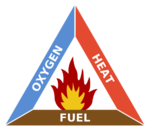
Fire extinguishing refers to the extinguishing of a fire. The chemical powder extinguisher is nowadays used for pretty much any type of fire, however appropriate fire extinguishing assumes analysing the fire class first, and then selecting a (environmentally harmless) extinguishing agent. For powder extinguishers, this means using particulate matter (ie sand, soil, ...), and for foam extinguishers, this means using a ecological soap mixed with water. CO² and FM 200 extinguishers can be used as is (already ecological). Both however only work in confined spaces (indoors).
Fire classes[edit | edit source]
| Class A | Class B | Class C | Class D |
|---|---|---|---|
| Ordinary combustibles | Flammable liquids | Flammable gases | Combustible metals |
| wood, paper, textile, artificial materials | gasoline, diesel, petroleum, paint thinner | propane, butane | magnesium, natrium, potassium, aluminum, alloys |
Appropriate extinguishers depending on fire class[edit | edit source]
- Class A: use water, or water + foam
- Class B: use powder, or CO² or FM 200
- Class C: use powder, or CO² or FM 200
- Class D: use powder, or CO² or FM 200
Note: never use water with class B fires, the water can spread the combustible fuel making the fire larger. Foam with water can also not be used with B fires, for the same reason. CO² finally can be used indoors, but make sure not to use it when inside the room (can asphyxiate the user).
How the agents extinguish the fire[edit | edit source]

| Extinguishing agent | Cooling | Expelling of oxygen | Negative catalysis |
|---|---|---|---|
| water | very good | good | no |
| water + foam | very good | very good | no |
| powder | no | good | yes (good) |
| CO² | no | very good | no |
| FM 200 | no | no | yes (very good) |